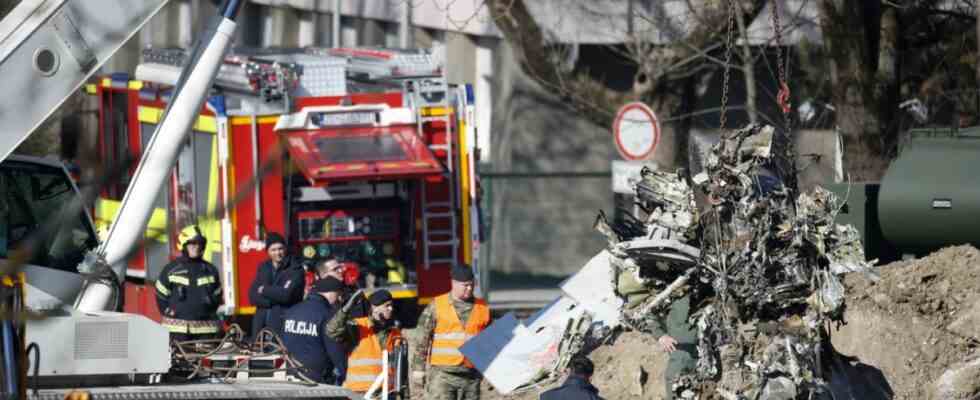It looked a bit like a toy, which children in a village called Răchițele in north-western Romania found on Sunday evening. Two wings with a span of a meter, a propeller, a few cables. But security agencies who later investigated the aircraft identified it as a surveillance drone, dude Orlan-10, Russian make. “It’s not a particularly large drone,” Romania’s Defense Minister Vasile Dincu said on Monday evening, and she didn’t have any explosives on board either.
According to the minister, contact was made with the authorities in neighboring Ukraine in order to find out exactly where the flying object had taken off from and who had piloted it into Romanian territory. In any case, Dîncu has already expressed a suspicion: It cannot be ruled out that the drone crash was used by Russia in a targeted manner as part of a campaign “to dissuade neighboring countries from supporting Ukraine”: After all, it is a well-known goal of “Russian propaganda to show solidarity destroy and terrify the people of this region”.
All reports and background information on the war in Ukraine – in the SZ in the morning and in the SZ in the evening. Our Messages–Newsletter brings you up to date twice a day. Free registration at sz.de/morgenabend. In our news app (download here) you can also subscribe to the news newsletter or our breaking news as a push message.
The shock waves of the war have long been felt in Romania, the southern neighboring country that shares a border of more than 600 kilometers with Ukraine. Even from the capital Bucharest, far to the south, there are reports of people packing emergency backpacks and making plans as to where they would flee in an emergency. The number of applications for passports at the competent authorities has recently skyrocketed.
Distrust of Moscow is traditionally much more pronounced in Romania than in the neighboring countries of Bulgaria and Serbia, which are closer to Russia linguistically, culturally and politically. In its 2020 national defense strategy, the government in Bucharest listed possible “aggressions” and “violations of international law” by Moscow among the greatest security risks.
US Vice President Harris was in Bucharest last week
And in the current crisis, Romania is unequivocally committed to its status as a NATO member – and is being upgraded accordingly by the partners in the defense alliance, given its proximity to Ukraine and also its Black Sea coast, as a strategically important post on the eastern flank. Visiting Bucharest last week, US Vice President Kamala Harris said: “We will defend every inch of NATO soil and I’m here to reiterate that commitment.” Take Article 5 of the agreement seriously, Harris said: “An attack against one is an attack against all.”
In addition to the 1,000 US soldiers already stationed in the country, another 1,000 are to be added, and the US is also sending additional fighter jets and interceptors as well as a missile defense system. Under French leadership, NATO is building a new multinational combat force in Romania, France and Belgium are strengthening their troops in the country, Germany and Italy are securing Romanian airspace with additional Eurofighters. Speaking to the US Vice President, Romania’s President Klaus Iohannis said he was “grateful for these unshakable security guarantees”; Because of this, “every Romanian citizen can sleep peacefully without having to worry about his safety and that of his family”.
On the other hand, it is precisely this clear positioning as a front-line state that gives some Romanians restless nights. Russia has also said it considers those countries through which military aid is supplied to the Ukrainian army to be belligerents. Ukrainian fighter jets have landed at a NATO base in Romania, according to the Moscow Defense Ministry last week; there they were taken care of and then flown back to fight against Russian troops; from Moscow’s point of view an “act of war”.
A drone also crashed in Croatia
The fact that the reconnaissance drone that crashed in the village of Răchițele was an instrument of Russian provocation to test the reactions on NATO’s eastern flank seems plausible in this context – especially since a drone crashed in Croatia last week, near a student residence in Croatia the capital Zagreb. In that case it was a much larger model, Soviet-made, 14 meters long and weighing six tons; According to Zagreb Mayor Tomislav Tomašević, it was “a miracle that nobody was injured”. According to the Defense Ministry, traces of explosives were found at the crash site, although it was unclear whether the drone was armed, as authorities initially said, or rather equipped with a self-destruct mechanism.
It was also unclear whether the drone, which apparently came from Ukraine, was launched by Ukrainian or Russian troops. In any case, Croatia’s Prime Minister Andrej Plenkovic expressed his irritation that the drone was apparently able to fly over two other NATO countries – Romania and Hungary – on its way to Zagreb. The Ministry of Defense in Bucharest said the object had been located during its three-minute flight over Romanian territory, but the “high speed and low altitude” combined with the weather conditions made it impossible to initiate further identification measures.
NATO Secretary General Jens Stoltenberg said in Brussels on Tuesday that investigations so far indicate that the drone went off course and then crashed for lack of fuel. The incident shows how important it is to improve the exchange of information between allies and to invest more in radar and air defense systems.

